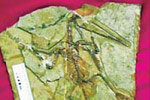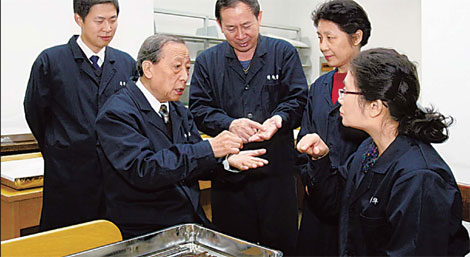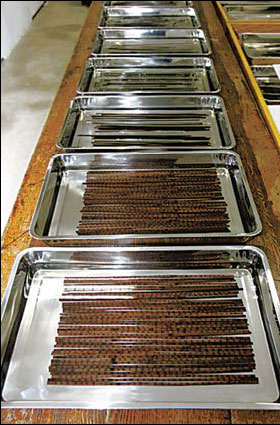Life
Secret of the bamboo code
Updated: 2011-01-25 07:52
By Cheng Yingqi (China Daily)
|
Tsinghua University researchers discuss the protection of the bamboo slips. Photos by Guo Haijun / For China Daily |
Understanding cryptic slips from the Warring States Period (475-221 BC) is a painstaking process, but the first findings are already exciting academicians. Cheng Yingqi reports.
The deciphering of a small batch of 2,500 bamboo slips, dating back to the Warring States Period (475-221 BC) and discovered in 2008, offers valuable insight into a little known period of Chinese history. Eight chapters, probably belonging to The Book of History, or Shangshu, the principal historical document of the period before the Qin Dynasty (221-206 BC), are included in the recently published book, Warring States Bamboo Slips Collected by Tsinghua University I. It marks the first time in 2,000 years the contents of Shangshu have appeared in public.
The Tsinghua University research team released the book on Jan 5. Besides containing the missing chapters of Shangshu, it also includes one story about the origin of the Chu State.
Shangshu is regarded as one of the Five Classics of China. More than half the 100-chapter book is believed to have been lost to the book-burning campaign of Emperor Qin Shihuang (259-210 BC).
King of the Qin State before becoming China's first emperor, he conquered its five neighboring states in 211 BC and ordered the burning of most books found in his empire so as to avoid scholars' comparison of his reign with that of past kings.
Some 460 scholars were buried alive for owning forbidden books. While the destruction of obsolete scripts helped accelerate Qin Shihuang's reform of the Chinese-language writing system, it also made the task of identifying the meaning of ancient characters on historic relics a formidable one for ancient archeologists.
The Tsinghua team has found some never-before-seen characters on the new lot of bamboo slips.
|
The bamboo slips are soaked in distilled water. |
"These characters were probably misused by people after the Qin Dynasty, who did not write the characters of the Chu State well," says Li Xueqin, head of the 10-person study team, formed in July 2008.
"These strange characters can probably explain why so many sentences in Shangshu were not coherent - because ancient Chinese scholars misread them."
After the fall of the Qin Dynasty, scholar Fu Sheng came out with a new text version of Shangshu, which left out more than 72 chapters of the original. During the last half of the 2nd century BC, an old text version started going around but that, too, was lost. Six hundred years later, in the 4th century, scholar Mei Ze allegedly rediscovered the old text and presented it to the imperial court.
But all the versions contained grammatically incorrect sentences. The newly discovered characters could help crate a new, more complete version of Shangshu.
"The Warring States Period was a flourishing one, and this meant many different styles of characters came about in different regions," says Zhao Ping'an, deputy director of the Center for Excavated Texts Research and Protection, Tsinghua University (CETRP).
The characters of the Chu State (one of the Three Kingdoms) on these bamboo slips are "among the most difficult-to-identify characters of this period", Zhao says.
In July 2008, Zhao Weiguo, an alumnus of Tsinghua University, donated about 2,500 bamboo slips to the university after obtaining them through auction in Hong Kong.
They were believed to have been stolen from a tomb in Central China's Hunan or Hubei provinces, and shipped illegally to Hong Kong about four years ago, according to Su Jun, head of the Social Science Administration Office of Tsinghua University.
"This collection of bamboo slips contains 2,300 years of history. Even Sima Qian (ca. 145 or 135 BC-86 BC), the father of Chinese historiography, did not have a chance to see them," Su continues. "So you can imagine their great significance to ancient Chinese culture."
Nevertheless, some of the slips arrived in Tsinghua University in pieces.
"While most slips, 48 cm long and 1 cm wide, were well preserved, others were broken. In the worst case, one slip was just 10 cm long. Some were broken lengthwise and arrived just was 0.4 cm in width," says Zhao Guifen, who is in charge of preserving the bamboo slips at CETRP.
Having been buried for 2,000 years in the water-logged parts of Central China, the bamboo pieces were at risk of disintegrating into powder when exposed to air.
"The water had damaged the bamboo cell leaving them as soft as noodles, and vulnerable to breaking," Zhao says.
Also, many of the slips had a thick layer of mildew on them, so scientists had to spent the first three months just cleaning them. They first used anti-corrosive drugs to sterilize the bamboo slips; and then got rid of the clay sticking to them through the use of a special brush, before bathing them repeatedly in distilled water.
"The slips were so fragile that we had to tie them to glass sheets, and store them in controlled temperature, humidity and light conditions," Zhao says.
As such fragile pieces cannot be moved back and forth, the researchers took photographs of both sides of the 2,500 slips and magnified the characters on them.
They found more than 60 chapters of ancient prose, on history, on the front of these slips, with the reverse of many being left blank.
"It felt like solving a photo puzzle, only much harder. You have to match the slips and link up the text," says Li Xueqin.
"We have deciphered the meaning of just a small portion of the slips over the past two years. It is like looking for a needle in a haystack," group member Li Shoukui says.
It could take another 15 years to decipher the entire lot, he says, adding that putting all the pieces together has also been a lot of fun.
"Knowing that a sentence will be complete and perfect only if you can find out another two small pieces written with the missing characters, means going through the slips again and again. But when you finally find it, the feeling is so marvelous you cannot describe it in words," he says.
For example, researchers simply could not seem to find a missing character in the article Baoxun and were about to publish it as is when a team member suddenly found what they were looking for and added it to the article at the very last minute before it went to press.
Specials

President Hu visits the US
President Hu Jintao is on a state visit to the US from Jan 18 to 21.

Ancient life
The discovery of the fossile of a female pterosaur nicknamed as Mrs T and her un-laid egg are shedding new light on ancient mysteries.

Economic Figures
China's GDP growth jumped 10.3 percent year-on-year in 2010, boosted by a faster-than-expected 9.8 percent expansion in the fourth quarter.

